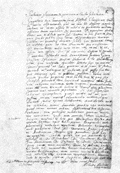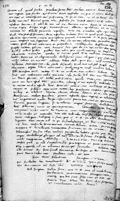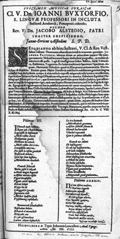
Sources
In 1898 Lajos Dézsi published two of Alsted's documents now available among Albert Szenci Molnár's personalia at the Library of the Hungarian Academy of Arts and Sciences: a letter Alsted wrote to Molnár dated from December 25 1609 and the presumably sole surviving copy of Alsted's Specimen musicae Ebraicae, Heidelberg, 1608.
1 Though three German scholars cited Molnár's letter to which Alsted wrote his answer and sent the specimen, this document has been hitherto unknown to the Early Hungarian Studies.2 Theodor Wotschke in his article on Alsted's Polish relations quoted Molnár's letter to maintain the idea by means of this indirect source that Alsted knew Johannes Turnovius (Jan Turnowsky). The reason why Wotschke did not publish the letter is self-evident as the researcher of the Polish reformation was interested only in the clue to Alsted's knowledge on Turnovius.3 Gerhard Menk, a distinct scholar of the early modern Calvinist intelligentsia, mentioned Molnár’s letter in his book on the Herborn Hohe Schule when discussing Alsted’s Hungarian (mostly Transylvanian) connections. However he also did not published and analised the source.4 Ingo Schultz in his doctoral dissertation on Alsted's musical theories quoted the letter twice, first in the list of Alsted's works (Verzeichnis der Schriften Alsteds), secondly to prove the fact of Alsted's 1608 stay in Heidelberg.51. Facsimile of Szenci Molnár's letter
2. The Transcription of Molnár's letter
6 with some commentaries on points I did not discuss in the main part of the article
Salutem plurimam et perennem in Christo felicitatem.
Singularis tua humanitas facit, Altstedi Clarissime, Domine et amice observande, qua me cum hic degeres complectebaris, ut etiam absens et nihil a te promeritus audeam officium tuum implorare, et exorare. Responsum debui veteri meo et dilecto amico Joh. Textori in sua patria, Heygerae scribae publico, (qui etiam disputationum tuarum thesybus me quandoque donare solet:)[7] Cui exaravi literas hic inclusas; quas ut tua Humanitas per occasionem ipsi transmittere velit rogo etiam atque etiam: et vicissim mea officia Tua H. amanter defero et spondeo.[8] Caeterum ostendit mihi ornatissimus Juvenis Georg. Vechner Specimen Musicae Hebraicae a te Heidelbergae editae, quo conspecto equidem laetatus sum ex animo Deum precatus ut hanc gratiam in te suam et studium eiusmodi in te adaugeat et confirmet, quo possis suo tempro[9] integrum opus [10] in publicum proferre: Erunt certe multi quibus pergratus erit labor tuus, et quis scit fortassis placuerit Deo, huiusmodi incentivis etiam Judaeorum caliginem excutere velle incipere: quemadmodum etiam de meos eiusmodi labores et Turcis olim placituros sperant mei nonnulli populares: Si tibi supersunt aliquot exemplaria quaeso mitte ad me, quo possim etiam amicis remotioribus mittere; qui eiusmodi studiis eximie delectantur[11]; antidoron mittere conabor[12]; nunc tantum gratias ago maximas, quod etiam nomen meum dedicatione tuae inserere volueris: cum potuisses nobiliorum gentium versiones nominare. Vidi ante annum etiam Castilica lingua versum [on the margins: + Psalterium] et hic pro illustrissimo nostro maecenate ligatum apud Bibliopegum. Comparavi mihi plearumque nationum versiones; Polonicum exemplar mihi promiserat Doct. Joh. Turnovius, quem gaudeo in Academiam Pragem esse promotum[13]. Sed haec parergos. Saluta quaeso ex me amanter et officiose Reverendum Dominum Piscatorem Dominum Tauberum, Reverendum Dominum Jacobum Hermannum, Dominum Pasorem et Dominum Corvinum quos omnes amo animitus. Bene et feliciter vale et habe tibi commendatum, harum latorem Dominum Johannem Helvetium Beilsteinensem, ante annos multos et Herbornae mihi notum, et hic convictorem exoptatissimum. Iterum vale et ignosce festinae scriptioni. Marpurgo. 18. decembr. 1609.
Tuus omni studio
Albertus Molnar Ungarus.
[Alsted's note:] Accepi. 21. decembr.
[Christoph Silder's note:] Huius Grammaticam in Hungaria didici. C. Silder.[14]
[Addressing on the envelope:] Viro Clarissimo Domino Johanni Henrico Alstedio in illustri Schola Nassovica Philosophiae Professori erudissimo: Amico meo dilecto et honorando. Herbornae.
3. Facsimile of Alsted's letter 
4. Facsimile of the Specimen musicae Ebraicae

5. Lajos Dézsi's transcritption of Alsted's letter and of the Specimen
-----------------------
Footnotes
1 Dézsi, Szenczi Molnár Albert naplója…, op. cit. pp. 332–334. The shelfmarks of the original manuscript and leaflet: MTA K 787/238. and MTA K 787/191. 2 HStAW Abt. 95. 320 II. fol. 8r 3 “Der Ungar Albert Molnar bekundet unter dem 18. Dezember 1609 Alsted seine Freude, sein in Heidelberg erschienenes “Specimen musicae hebraicae” erhalten zu haben. (...) Auch zwischen dem Senior der Brüderunität in Polen, Johann Turnovius, dem am 8. März 1608 Marburg den Doktorhut reichte, und unserem Herborner Gelehrten habe ich unmittelbare Beziehungen nicht feststellen können. Aber wenn der gedachte Ungar Molnar am 18. Dezember 1609 Alsted einfach schreibt: » Polonicum exemplar psalterii mihi promiserat doctor Joh. Turnovius« , so setzt er doch eine Bekanntschaft zwischen beiden voraus, dazu war der Marburger Professor Raphael Eglin ein Vertrauter beider." Wotschke, Theodor, Der Herborner Alsted verbindung mit Polen, Archiv für Reformationsgeschichte 33 (1936), 147. p. 4 Cf. Menk, Gerhard, Die Hohe Schule Herborn in ihrer Frühzeit (1584-1660). Ein Beitrag zum Hochschulwesen des deutschen Kalvinismus im Zeitalter der Reformation, Wiesbaden, 1981. p. 310. However Menk – after Wotschke – made a mistake in dating the Specimen musicae Ebraicae: “Auf ein weiteres, allerdings weniger bekanntes Buch [sic!] verweist Wotschke (ed.), Des Herborner Alsted Verbindung mit Polen, passim: Specimen musicae hebraicae, heidelberg 1609.” op. cit. p. 277. (see also p. 332.). For further reading on Alsted’s Hungarian connections see Menk’s Das Restitutionsedikt und die Kalvinistische Wissenschaft. Die Berufung Johann Heinrich Alsteds, Philipp Ludwig Piscators und Johann Heinrich Bisterfelds nach Siebenbürgen, Jahrbuch der Hessischen Kirchengeschichtlichen Vereinigung, 31 (1979). 5 "Vor der Rückkehr nach Herborn besuchte Alsted noch für kurze Zeit die Universitä t in Heidelberg. Trotz der unklaren Matrikeleintragung (...) können keine Zweifel über diesen Aufenthalt aufkommen, der sowohl durch einen Brief des ungarischen Bibelüberzetzers Albert Molnar (...) Molnar schrieb am 18. 9. [sic!] 1609 an Alsted: » Caeterum astendit [sic!] mihi ... specimen Musicae Hebraicae a te Heidelberga edita ...« . Hauptstaatsarchiv Wiesbaden. Abt. 95, 320 II, 8r ." Schultz, Ingo, Studien zur Musikanschauung und Musiklehre Johann Heinrich Alsteds (1588–1638), Inaugural–Dissertation zur Erlangung der Doktorwürde der Philosophischen Fakultä t der Philipps–Universitä t Marburg/Lahn, Marburg (Lahn), 1967. 30–31. pp. and note 26. on the same page. "Musica hebraica [sic!]. Heidelberg: 1608 (...) Auch von dieser frühen Schrift war kein Exemplar nachzuweisen. Lediglich der Titel kann hier erstmals mitgeteilt werden, wie er sich in einem Brief des ungarischen Bibelüberzetzers Albert Molnar vom 18. Oktober [sic!] 1609 an Alsted findet: » Caeterum astendit [sic!] mihi ... Specimen Musicae Hebraicae a te Heidelbergica edita ... « (Hessisches Hauptstaatsarchiv Wiesbaden. Abt. 95, 320 II, 8r)..." Ibid. p. 135. and n.12. 6 The original document is now available in the Hessisches Hauptstaatsarchiv Wiesbaden among the Personalia Alstedii (HStAW Abt. 95. Nr. 320. II. fol. 8r). 7 Cf. Alsted's apology in his letter concerning these theses: "Eum tibi subinde misisse Theses quasdam meas, indignor. Indignae enim sunt, quae a tua Humanitate et aliis academicis legantur. Nam meum est in iis s u g c a t a b a i ¢ n e i n et habere rationem auditorii." In Jörg Jungmayr's bibliography one can find some of these documents. See the reprint of Alsted's Encyclopaedia, op. cit. p. xxix. There is no surviving copy of the above mentioned theses in Molnár's personalia. 8 I do not know of any surviving copy of this letter Molnár sent to Textor with Alsted. According to Alsted's answer to Molnár, he presumably sent Textor's reply as an enclosure of his own letter: "Ceterum mitto literas communis nostri amici domini Textoris, viri integerrimi, qui recta ad recta tendit et contendit." However, this letter is missing from Molnár's album now available in Budapest. 9 suo tempore 10 Cf. that part of Alsted's letter where he promises a 'grandius opus': "Brevi, Deo clementer adiuvante, grandius opus mittam, quod ferme adornavi et propediem Waldkirchio Basileensi typographo mittam, qui cum ante biennium hac ipsa de re egi, eo loci dum agerem. Quod si videro probis probari haec talia, pro virili annitar, ut Musica Ebraeorum enitascat." I do not know any copy of this 'opus integrum', namely, of Alsted's entire Musica Hebraica. 11 It is fairly possible that Molnár under 'amici remotiores' meant his Hungarian and Transylvanian friends. On Molnár's request cf. Alsted's letter: "exemplaria paucula transmitto tuae Humanitati, quia pluscula nunc temporis non suppetunt." It is worth mentioning that the surviving copy of the Specimen was wrongly arranged in Molnár's personalia (MTA K 787/191.). Now it is available among the 1608 documents, since it was ranked according to its publication date, however it is evident that Alsted sent it together with his 1609 letter (MTA K 787/238.). 12 There is no evidence of any surviving copy of this present. 13 It is rather odd that Szenci Molnár here indicated Prague as the place of Turnovius' 'promotio', although his diary suggests Marburg. See Dézsi, Lajos, Szenci Molnár naplója..., op. cit. p. 48. Cf. also Wotschke: "Johann Turnovius, dem am 8. März 1608 Marburg den Doktorhut reichte" op. cit. p.147. Turnovius finally published his Psalterz Dawidow in 1624 in Krakowie. Cf. Bibliografia polska Karola Estreichera..., Kraków, 1936., Czesci III. tom. XX.: Litera T., p. 406. 14 On Silder see Die Matrikel der Hohen Schule und des Paedagogiums zu Herborn, Hrsg. von Gottfried Zedler u. Hans Sommer, Wiesbaden, 1908. p.113. p. 341. p. 347. p. 355. p. 357. (Veröffentlichungen der Historischen Komission für Nassau 5). As Alsted's grandson (Alstedii unicus ex filia nepos), he came to Herborn from Transylvania Sárospatak – presumably because of the 1658 invasion of the Tartars which destroyed the Collegium Bethlenianum at Gyulafehérvár – and enrolled into the Paedagogium in 1659: "Die 18. Julii 1659 e trivio Rivulino ad nos venit: [4510] Christophorus Silderus nobilis Rivulinus, Alstedii unicus ex filia nepos, Ungarus et praemisso examine tertia dignus habitus est." Cf. Die Matrikel..., op. cit. p. 341. Silder studied Molnár's Nova Grammatica Ungarica in Sárospatak at elemetary school (trivium Rivulinum sive Patakhinum). See also Silder’s letters in the Personalia Alstedii (HStAW Abt. 95. Nr. 320. I. fol. 189r and 191r), and his mother’s letter from Transylvania (184r). Menk has already quoted a letter to Ludwig Heinrich written by Christop’s father H. Schilder (183r–184v), see his monography, op. cit. p. 309. Although it does not refer to Silder, on the Transylvanian life of the Alsted-family after the professor's death see János Herepei's article: 'Alsted professzor családja és adatok a Danczkával való kulturális kapcsolatainkhoz', Mûvelõdési törekvések a század második felében. Herepei János cikkei, ed. Bálint Keserû, Budapest–Szeged, 1971, pp. 384-389. (Adattár XVII. századi szellemi mozgalmaink történetéhez 3)